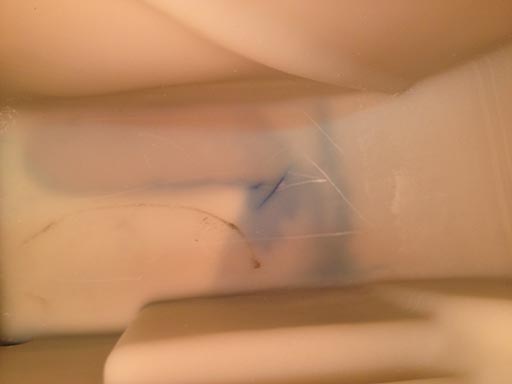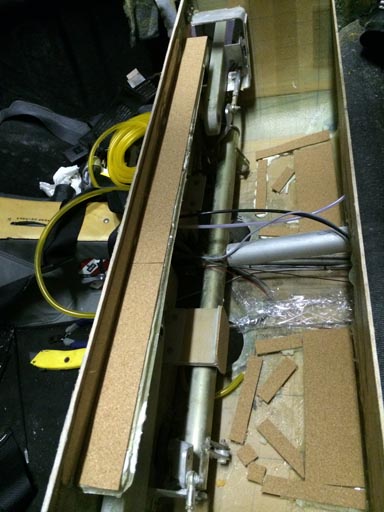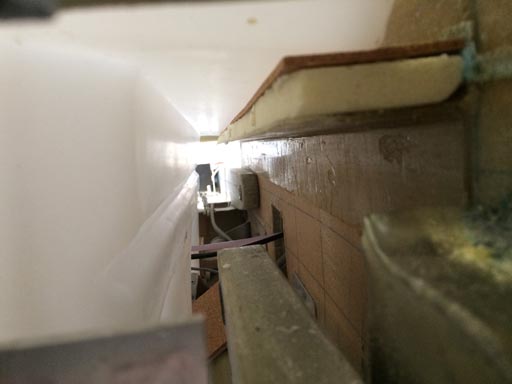rlborger(at)mac.com
Guest
|
 Posted: Sun Mar 30, 2014 2:31 pm Post subject: Fwd: XS Fuel Tank Kiwi Mod Posted: Sun Mar 30, 2014 2:31 pm Post subject: Fwd: XS Fuel Tank Kiwi Mod |
 |
|
Sorry guys, missed a picture in the original post
Begin forwarded message:
From: Robert Borger <rlborger(at)mac.com (rlborger(at)mac.com)>
Subject: Re: XS Fuel Tank Kiwi Mod
Date: March 30, 2014 at 5:13:40 PM CDT
To: europa-list(at)matronics.com (europa-list(at)matronics.com)
Hi Fred,
I used Bud’s instructions for the fuel tank replacement.
Andrew Sarangan and I sent our tanks out for heavy-duty fluoridation.
No, I did not make cuts before fluoridation.
Yes, to the stress concentrations caused by the fiberglass “shelf." My tank cracked right at the corners of one of those fiberglass layups:
[img]cid:64619E84-D1BA-4D2B-B86C-A6DDB1BC9EA5[/img]
In this view the top of the tank is off and you are looking down into the port side of the tank. The crack is pretty well defined in blue and is right on the corner of the outside, forward corner of the “shelf.” Right at the 45º predicted by stress analysis.
Kinda/sorta, the fix is to provide support under the tank. The rear “shelf” is still there attached to the rear bulkhead which carries most of the load supported on a layer of cork. There is also support built under the forward part of the bottom of the tank. This is a thick micro applied in lines upon which the tank was set (plastic wrap used as a parting agent) and the micro allowed to cure. The micro was also covered with cork. The micro is not to provide primary support only secondary support should the gas soften the tank and allow some sag. The micro would support the sag rather than sagging over the shelf causing another stress riser.
[img]cid:B897072D-70D5-4A90-93AD-99AF78CCD8CE[/img]
The aluminum T shelf on the front bulkhead had a layer of urethane foam bonded on top to support the ledge of the tank. This was also covered with cork.
[img]cid:303EFBE6-3486-457C-9F40-977668A5C1D0[/img]
From my (very limited) research on this issue it appears that tank cracking is a combination of things. First, of tank softening due to the absorption of fuel or solvents in the fuel. Second, softening causing sagging. Third, stresses induced by sagging over a corner of the fiberglass used to support the tank on the aft bulkhead. Fourth, perhaps the tank becoming brittle and more susceptible to cracking by removal of the fuel and subsequent evaporation of the fuel or solvent from the softened fuel tank material. I’ve seen pictures of a crack virtually identical to mine only on the starboard side. I also saw a picture of a crack on the starboard side corner of the fiberglass support in the tunnel area.
Some sort of support is needed under the tank to prevent the sagging causing stress risers on the corners of the fiberglass. I’m providing support as suggested by Bud in his fuel tank replacement guide.
Bud has his fuel tank replacement instructions available on his company website.
Being fulla questions isn’t a problem. I just hope you can get satisfactory answers for them.
Blue skies & tailwinds,
Bob Borger
Europa XS Tri, Rotax 914, Airmaster C/S Prop (50 hrs).
Little Toot Sport Biplane, Lycoming Thunderbolt AEIO-320 EXP
3705 Lynchburg Dr.
Corinth, TX 76208-5331
Cel: 817-992-1117
rlborger(at)mac.com (rlborger(at)mac.com)
On Mar 30, 2014, at 1:39 PM, Fred Klein <fklein(at)orcasonline.com (fklein(at)orcasonline.com)> wrote:
--> Europa-List message posted by: Fred Klein <fklein(at)orcasonline.com (fklein(at)orcasonline.com)>
On Mar 30, 2014, at 10:53 AM, Robert Borger <rlborger(at)mac.com (rlborger(at)mac.com)> wrote:
| Quote: | Gentlemen,
Having just replaced my fuel tank, I can speak to this issue. I did the replacement with doors on & wings off. There is one issue in fitting the new tank. The door sill on one side must be cut out to allow the new tank to go in:
|
Bob…sorry to hear that you’ve had to go this, but grateful for your insights into and photos of the process. When installing the new tank, were you following any explicit instructions (from where/who?) as to how best to support and secure the tank?
Did you consider having your tank treated w/ additional fluoridation treatment? If so, did you make all cuts into the tank before sending it off for treatment?
(It’s been my understanding that the cracks were the result of stress concentrations caused by the fiberglass shelf and supports bonding to the tank; consequently I’ve presumed that the “fix”, in addition to the new tank itself, was to ensure there was a bond break or slip sheet between the new tank and it’s supports…but perhaps I’m mistaken, and the brittleness and subsequent cracking is a consequence of fuel interacting w/ the tank material alone, irrespective of potential stress concentrations caused by portions of the tank being unable to expand and contract…?…)
…jus fulla questions, but tryin to get my head around this...
Fred
| | - The Matronics Europa-List Email Forum - | | | Use the List Feature Navigator to browse the many List utilities available such as the Email Subscriptions page, Archive Search & Download, 7-Day Browse, Chat, FAQ, Photoshare, and much more:
http://www.matronics.com/Navigator?Europa-List |
|
| Description: |
|
| Filesize: |
26.17 KB |
| Viewed: |
1202 Time(s) |

|
| Description: |
|
| Filesize: |
59.27 KB |
| Viewed: |
1202 Time(s) |

|
| Description: |
|
| Filesize: |
34.66 KB |
| Viewed: |
1202 Time(s) |

|
|
|





